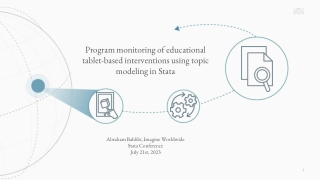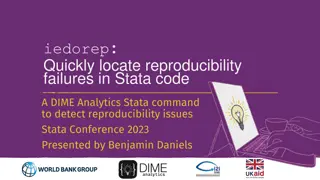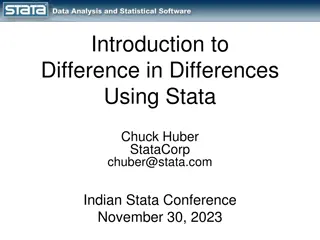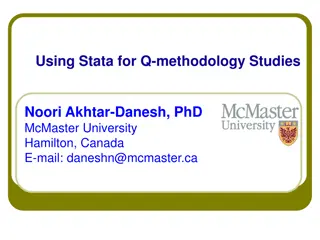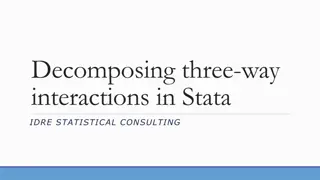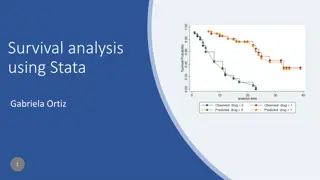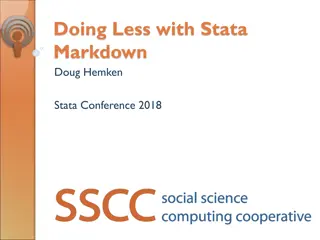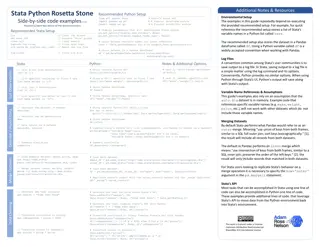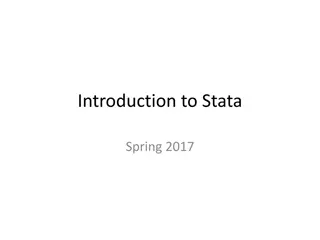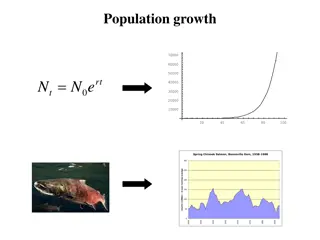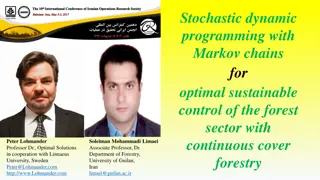Panel Stochastic Frontier Models with Endogeneity in Stata
Introducing xtsfkk, a new Stata command for fitting panel stochastic frontier models with endogeneity, offering better control for endogenous variables in the frontier and/or the inefficiency term in longitudinal settings compared to standard estimators. Learn about the significance of stochastic frontier models (SFM) and how endogeneity can impact model outcomes. Explore the limitations of existing commands and the introduction of xtsfkk for estimating panel stochastic frontier models with endogeneity in Stata.
Download Presentation

Please find below an Image/Link to download the presentation.
The content on the website is provided AS IS for your information and personal use only. It may not be sold, licensed, or shared on other websites without obtaining consent from the author. Download presentation by click this link. If you encounter any issues during the download, it is possible that the publisher has removed the file from their server.
E N D
Presentation Transcript
Panel Stochastic Frontier Models with Endogeneity in Stata Mustafa U. Karakaplan
Introduction I introduce xtsfkk as a new Stata command for fitting panel stochastic frontier models with endogeneity. The advantage of xtsfkk is that it can control for the endogenous variables in the frontier and/or the inefficiency term in a longitudinal setting. xtsfkk performs better than standard panel frontier estimators such as xtfrontier that overlook endogeneity by design.
About SFM It has been more than 40 years since Aigner, Lovell, and Schmidt (1977) and Meeusen and van den Broeck (1977) introduced stochastic frontier models (SFM). These models are composed of a deterministic part identifying the frontier, a stochastic part for the two-sided error term, and a one-sided inefficiency error term identifying the distance from the stochastic frontier. These models can be used to study production, cost, revenue, profit, or other goals within various industries such as accounting, advertising, banks, education, financial markets, environment, hospitals, hotels, labor markets, military, police, real estate, sports, transportation, and utilities.
SFM in Stata Stata provides the frontier command to estimate the parameters of a stochastic frontier model. Belotti, et al. (2013) introduce a Stata command called sfcross that mirrors Stata s frontier command with additional functionality, options, and models. The standard xtfrontier command of Stata and sfpanel command of Belotti, et al. (2013) estimate panel stochastic frontier models However, the literature on stochastic frontier models, various Stata commands, and the estimator options in other general-purpose statistical software packages does not offer a way to control for endogeneity that can exist in these models.
Endogeneity in SFM If the determinants of the frontier or the inefficiency term are correlated with the two-sided error term of the model, then the outcomes of the standard estimators would be contaminated by endogeneity. Kutlu (2010) and Karakaplan and Kutlu (2017a) developed a model to handle endogeneity due to the determinants of the frontier or the inefficiency term, or both. Karakaplan (2017) released a new Stata command called sfkk to analyze empirical stochastic frontier models with endogeneity.
Panel SFM with Endogeneity in Stata One shortcoming of Karakaplan and Kutlu (2017a) and the sfkk command of Karakaplan (2017) is that their model was designed to be cross-sectional. Karakaplan and Kutlu (2017b) came up with a stochastic frontier estimator that would resolve endogeneity issues in a panel setting. The standard xtfrontier command of Stata and sfpanel command of Belotti, et al. (2013) estimate panel stochastic frontier models but cannot handle the endogeneity issues identified by Karakaplan and Kutlu (2017b). Therefore, in this paper, I introduce a new command, xtsfkk, for estimating panel stochastic frontier models with endogeneity in Stata.
About the Command Using Stata s maximum likelihood estimator tools (the ml commands), and the guidance provided by Gould, Pitblado, and Poi (2010), I programmed the xtsfkk command that can calculate the estimator and efficiency equations presented in Karakaplan and Kutlu (2017b). Three files are included in the xtsfkk command package: xtsfkk.ado file for the main estimation syntax that users can access by running xtsfkk in Stata, xtsfkk_ml.ado file for the evaluator subroutines that xtsfkk calls for behind the scenes, and xtsfkk.sthlp file for helping users when help xtsfkk is run in Stata. Syntax: xtsfkk depvar [indepvars] [if] [in] [weight] [, options]
About the Command Options Users can run help xtsfkk in Stata for the full-length documentation of the xtsfkk syntax, options, stored results, and other details. Some standard options of xtsfkk are: production cost endogenous(endovarlist) instruments(ivarlist) uhet(uvarlist) whet(wvarlist)
Some Other Important Options Some other important options of xtsfkk: efficiency(effvar[, replace]) generates the production or cost efficiency variable once the estimation is completed, and displays its summary statistics in detail. test provides a method to test the endogeneity in the model. This option tests the joint significance of the components of the eta term, and reports the findings after displaying the regression results. For more information about test see Karakaplan and Kutlu (2017b). save option saves the current state of the estimation in real-time while the estimation is running. load option loads a previously saved state of an estimation and continues from where it was left.
Examples Users can run help xtsfkk in Stata for several examples about the usage of the xtsfkk command. Panel Stochastic Cost Frontier Model with Endogeneity: Panel data include 85 individuals and a total of 300 observations between 2011 and 2015. This unbalanced dataset is for illustrative purposes and does not characterize a certain sector. Cost (y) is modeled as a function of two frontier variables (x1 and z1) Cost inefficiency is modeled as a function of a variable (z2). Two instrumental variables (iv1 and iv2) are used to handle the potential endogeneity of two variables (z1 and z2) in the model.
Estimation The header option displays the model fully. The compare option displays the results from exogenous model. The nicely option displays the results in a single table using estout command of Jann (2005). . use http://www.mukarakaplan.com/files/xtsfkkcost.dta, clear . xtset id t panel variable: time variable: id (unbalanced) t, 2011 to 2015, but with gaps 1 unit delta: . xtsfkk y x1 z1, cost u(z2) en(z1 z2) i(iv1 iv2) header compare nicely ENDOGENOUS PANEL STOCHASTIC COST FRONTIER MODEL (Model EN) Dependent Variable: y Frontier Variables: Constant x1 z1 U Variables: Constant z2 W Variable: Constant Endogenous Variables: z1 z2 Added Instruments: iv1 iv2 Exogenous Variables: iv1 iv2 x1 Panel Variable: id Time Variable: t
Estimation Results Model EX Model EN Model EX is the model that ignores endogeneity, and Model EN is the model that handles endogeneity. Individual eta terms for z1 and z2 are both statistically significant at the 0.1% level and the eta endogeneity test result rejects the null hypothesis at 0.1% level, which indicates that a correction for endogeneity in the model is necessary. The coefficients of z1 and z2 in Model EX are positive and statistically significant. In Model EN, these coefficients are significant and positive but smaller. Mean cost efficiency in Model EX is 0.3625, while in Model EN, the same statistic is 0.4838. So, individuals in this data are more cost efficient than how they would seem in Model EX that overlooks endogeneity. ---------------------------------------------------------------- Dep.var: y Constant 0.391** x1 0.136* z1 0.963*** ---------------------------------------------------------------- Dep.var: ln(sigma _u) Constant -0.544* z2 1.190*** ---------------------------------------------------------------- Dep.var: ln(sigma _v) Constant -1.503*** ---------------------------------------------------------------- Dep.var: ln(sigma _w) Constant ---------------------------------------------------------------- eta1 (z1) eta2 (z2) ---------------------------------------------------------------- eta Endogeneity Test ---------------------------------------------------------------- Observations 300 Log Likelihood -302.44 Mean Cost Efficiency 0.3625 Median Cost Efficiency 0.3341 ---------------------------------------------------------------- Notes: Standard errors are in parentheses. Asterisks indicate significance at the 0.1% (***), 1% (**) and 5% (*) levels. (0.129) (0.068) (0.047) 0.295* 0.494*** 0.746*** (0.136) (0.092) (0.097) (0.251) (0.068) -0.945*** 1.131*** (0.215) (0.063) (0.097) -1.918*** (0.094) 0.421*** 0.568*** (0.109) (0.055) X2=138.68 p=0.000 300 -782.62 0.4838 0.4976
Conclusion xtsfkk is a new Stata command to estimate endogenous panel stochastic frontier models. xtsfkk can handle endogenous variables in the frontier and/or the inefficiency, and studies and examples show that xtsfkk estimates outperform the standard frontier estimates that ignore endogeneity. xtsfkk provides many options that can become handy for researchers from many different fields such as agriculture, airline, banking, education, energy, and health. For updates, comments, suggestions, or questions about xtsfkk: mukarakaplan@yahoo.com www.mukarakaplan.com



